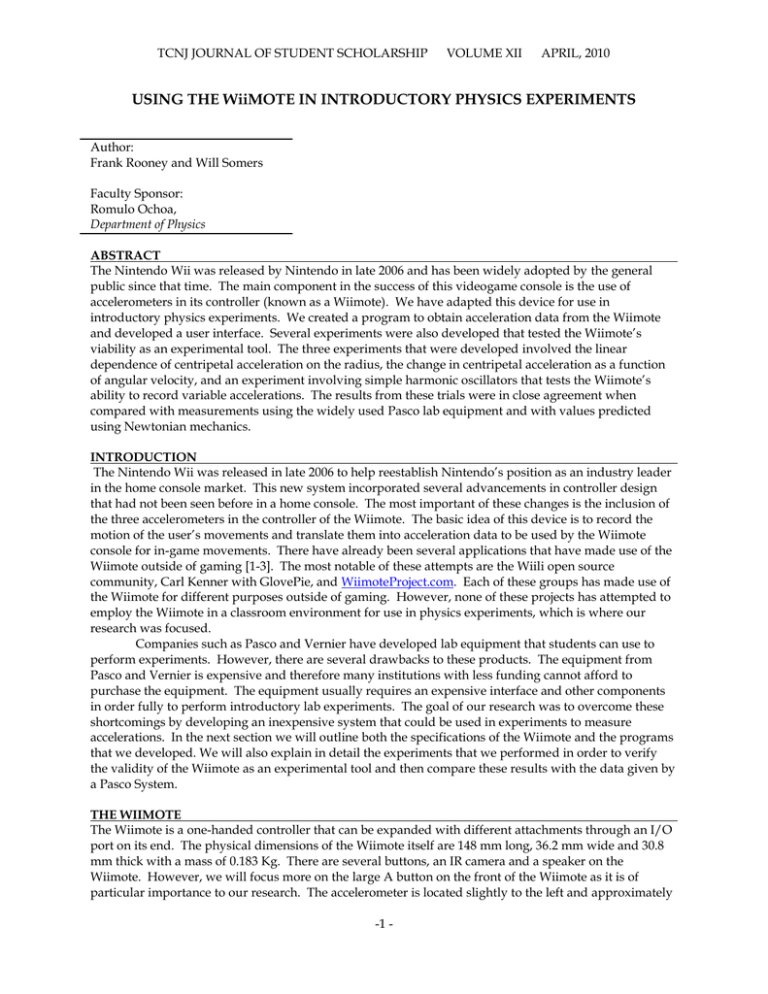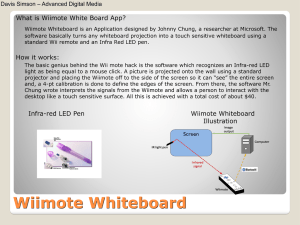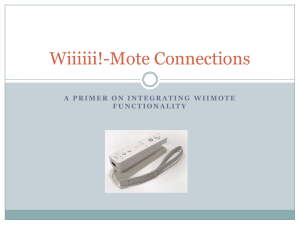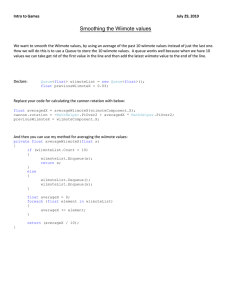USING THE WiiMOTE IN INTRODUCTORY PHYSICS EXPERIMENTS
advertisement

TCNJ JOURNAL OF STUDENT SCHOLARSHIP VOLUME XII APRIL, 2010 USING THE WiiMOTE IN INTRODUCTORY PHYSICS EXPERIMENTS Author: Frank Rooney and Will Somers Faculty Sponsor: Romulo Ochoa, Department of Physics ABSTRACT The Nintendo Wii was released by Nintendo in late 2006 and has been widely adopted by the general public since that time. The main component in the success of this videogame console is the use of accelerometers in its controller (known as a Wiimote). We have adapted this device for use in introductory physics experiments. We created a program to obtain acceleration data from the Wiimote and developed a user interface. Several experiments were also developed that tested the Wiimote’s viability as an experimental tool. The three experiments that were developed involved the linear dependence of centripetal acceleration on the radius, the change in centripetal acceleration as a function of angular velocity, and an experiment involving simple harmonic oscillators that tests the Wiimote’s ability to record variable accelerations. The results from these trials were in close agreement when compared with measurements using the widely used Pasco lab equipment and with values predicted using Newtonian mechanics. INTRODUCTION The Nintendo Wii was released in late 2006 to help reestablish Nintendo’s position as an industry leader in the home console market. This new system incorporated several advancements in controller design that had not been seen before in a home console. The most important of these changes is the inclusion of the three accelerometers in the controller of the Wiimote. The basic idea of this device is to record the motion of the user’s movements and translate them into acceleration data to be used by the Wiimote console for in-game movements. There have already been several applications that have made use of the Wiimote outside of gaming [1-3]. The most notable of these attempts are the Wiili open source community, Carl Kenner with GlovePie, and WiimoteProject.com. Each of these groups has made use of the Wiimote for different purposes outside of gaming. However, none of these projects has attempted to employ the Wiimote in a classroom environment for use in physics experiments, which is where our research was focused. Companies such as Pasco and Vernier have developed lab equipment that students can use to perform experiments. However, there are several drawbacks to these products. The equipment from Pasco and Vernier is expensive and therefore many institutions with less funding cannot afford to purchase the equipment. The equipment usually requires an expensive interface and other components in order fully to perform introductory lab experiments. The goal of our research was to overcome these shortcomings by developing an inexpensive system that could be used in experiments to measure accelerations. In the next section we will outline both the specifications of the Wiimote and the programs that we developed. We will also explain in detail the experiments that we performed in order to verify the validity of the Wiimote as an experimental tool and then compare these results with the data given by a Pasco System. THE WIIMOTE The Wiimote is a one-handed controller that can be expanded with different attachments through an I/O port on its end. The physical dimensions of the Wiimote itself are 148 mm long, 36.2 mm wide and 30.8 mm thick with a mass of 0.183 Kg. There are several buttons, an IR camera and a speaker on the Wiimote. However, we will focus more on the large A button on the front of the Wiimote as it is of particular importance to our research. The accelerometer is located slightly to the left and approximately -1 - F. ROONEY AND W. SOMERS: USING THE WiiMOTE 0.8 cm above the middle of this button, below the casing. The accelerometer that Nintendo uses in the construction of the Wiimote is the ADXL330 3-axis iMEMS manufactured by Analog Devices Inc of Norwood, MA [4]. This accelerometer has a stated sensitivity of approximately +/- 3g and is able to tolerate 10,000 g’s before failure [4]. The Wiimote communicates with the PC through Bluetooth. The Bluetooth chip in the Wiimote is manufactured by Broadcom. Many accelerometers that are used in lab experiments cost hundreds of dollars. The advantage of using the Wiimote is that it is readily available and is relatively inexpensive at approximately 40 dollars. It is untethered and has a range of 10 meters. The Broadcom chip allows students to perform experiments away from the computer when collecting data [5, 6]. Thus, experiments can be performed that were not previously possible with the equipment from current manufacturers. The Wiimote has a higher sample rate than that of the Pasco or the Vernier equipment. Through the use of the program that we developed, the Wiimote is able to achieve sample rates of approximately 1 to 500 Hz, in comparison with the Pasco equipment which has a limit of 120Hz. A photo of the Wiimote is shown in Figure 1. Figure 1. Photo of a Wiimote. The 3-axis accelerometer is to the left of the A button. SOFTWARE DEVELOPED AND COMPONENTS USED There were multiple programs that were used in order to gain useable data from the Wiimote. The main program which interfaced with the Wiimote was GlovePie. GlovePie was originally intended to interface with a variety of devices. It was later modified by its creator, Carl Kenner, to include support for the Wiimote [7]. The program gains input from the Wiimote directly and can perform a variety of functions associated with introductory physics experiments. The version of GlovePie that was used with our experiments was version .30. This version of GlovePie was chosen because it allowed support for the Wii balance board, which will to be incorporated into several experiments in the future. Since the Wiimote communicates through Bluetooth to a PC or a Wii, we required an appropriate Bluetooth stack. We used the Toshiba Bluetooth Stack, a protocol stack that was developed by Toshiba, and shipped with the USB micro adapter. A Bluetooth stack implements the Bluetooth protocol. The protocol is a list of commands that all Bluetooth devices use, while the stack is the code that instructs them to execute. We found that this Bluetooth stack was the best choice for our purposes because it could easily connect to the Wii balance board, allowing us to expand our experiments in the future. We developed a user interface in order to allow a user easily to obtain data from the Wiimote. This program when prompted will automatically launch and set up the Wiimote to start taking data. It also has a graphing function that allows users to view the data graphically as it is being recorded. This program automatically launches itself and associates all GlovePie scripts with GlovePie so that a user to easily identify the programs. The program consists of a group of batch files which are written in notepad and give instructions Windows XP or Vista (Microsoft). Since the computers that we were using in our lab did not have internal Bluetooth antennae, we had to purchase one in order for our PC to connect to the Wiimote. We chose the Kensington micro USB adapters for our purposes, which provided the best response and were easily able to communicate with -2- TCNJ JOURNAL OF STUDENT SCHOLARSHIP VOLUME XII APRIL, 2010 both the Wiimote and the Wii balance board. A list of compatible USB adapters is available through the Wiili group at the following link: http://www.wiili.org/index.php/Compatible_Bluetooth_Devices. EXPERIMENTS AND RESULTS In order to verify that the Wiimote was capable of giving accurate results in introductory physics experiments, we needed to design experiments to test its abilities. The three experiments which we performed were the linear dependence of centripetal acceleration based on the radius, the change in centripetal acceleration based on a variable angular velocity, and an experiment that involves simple harmonic oscillators to test to the Wiimote’s ability to record variable acceleration. In the experiments, which we outline below, we used the Wiimote to complement the data from the Pasco motion sensor and the photogate used as a smart pulley. We found that although the Pasco motion sensor gives accurate data on position, the data becomes very noisy when it determines the acceleration. The Wiimote gives much more accurate results than the Pasco system. The Wiimote can also produce a much smoother curve at a much higher sampling rate. Uniform Circular Motion To verify that the Wiimote could give accurate results and that the acceleration values were linear, we attached the Wiimote to a rotating beam. Two experiments were conducted using this setup. The setup for this experiment is shown in Figure 2. The data was collected using GlovePie, and then was output to a file. It was then graphed and analyzed using Excel (Microsoft). Wiimote Rotating platform Photogate Figure 2. Schematic diagram of the centripetal motion setup used to verify the Wiimote’s acceleration readings. The photogate measures the period of each rotation and is connected to a Science Workshop interface. Figure 3 shows the centripetal acceleration versus the radius of the rotating beam for the Wiimote and the calculated acceleration. The centripetal acceleration was calculated by taking the period measured by a photogate and using the radius at which the accelerometer was located. Since the accelerometers are located approximately to the left and at the center of the A button the uncertainty in the radius was about 0.005 m or 0.5 cm. The solid line in Figure 3 is a linear fit to the calculated values of the acceleration. -3 - F. ROONEY AND W. SOMERS: USING THE WiiMOTE Figure 3. Centripetal acceleration versus radius graph for the Wiimote (circles) and calculated from photogate measurements (triangles). The vertical uncetainity is smaller than the symbol’s height for both cases. The straight line is a regression fit to the calculated data. Another experiment was conducted using the rotating beam. The same setup was used for this experiment; however, during this experiment the Wiimote was fixed at the 10 cm mark on the beam and then the beam was rotated at different angular velocities. Figure 4 shows the inverse quadratic relationship between the angular acceleration and the distance from the center of the rotating beam. There is approximately an average of 3.6% difference between the value from the Wiimote and the calculated value. We also plotted the centripetal acceleration versus the square of the angular velocity for a visual aid as it shows a linear trend. -2- TCNJ JOURNAL OF STUDENT SCHOLARSHIP VOLUME XII APRIL, 2010 Figure 4. The top figure shows the Wiimote’s acceleration vs. its period. The inverse quadratic relationship is apparent. The Wiimote’s data are represented by squares and those of the photogate by diamonds. The bottom figure shows the acceleration versus the square of the angular velocity. A trend line was added for a visual aid. Its slope of 0.075 m indicates the location of the accelerometer. Simple harmonic motion The next set of experiments tested the ability of the Wiimote to measure variable accelerations. The first experiment consisted of attaching the Wiimote to a vertically suspended spring. Since this system has sinusoidal time dependence, it easily showed the variable acceleration that the Wiimote was able to record. We performed two trials of this experiment, one with the sample rate set to 40Hz and another with the sample rate set to 100Hz. In order to validate whether or not the Wiimote was taking accurate data, we used a Pasco motion sensor in conjunction with the Wiimote setup. We also set the Pasco motion sensor to the 40Hz and 100Hz sample rates. -5 - F. ROONEY AND W. SOMERS: USING THE WiiMOTE Figure 5. The top figure shows the acceleration versus time for the harmonic oscillation experiment with the Wiimote sample rate at 40 Hz. The bottom figure shows the acceleration versus time obtained with the Pasco system sample rate at 40 Hz. Figure 5 shows the results from the trial at 40Hz for the Wiimote and from the trial at 40Hz for the Pasco motion sensor. There is sinusoidal time dependence and the amplitude of the acceleration for the Wiimote trial and the Pasco trials were in agreement at approximately 2.86 m/s2. The initial displacement was 10 cm and it had a natural angular frequency of 6.11 Hz. Figure 6 shows the acceleration versus time graph obtained using the Wiimote and the Pasco motion sensor set at 100 Hz. It clearly shows the expected sinusoidal time dependence. The initial conditions were the same as in the previous situation. The acceleration amplitude of 2.5 m/s2 agrees well with the value calculated from using ω2A (with ω the angular frequency and A the amplitude of motion). The position data collected by the motion sensor was very smooth. However, the acceleration data from the Pasco motion sensor trials at 40Hz and 100Hz was noisy. -2- TCNJ JOURNAL OF STUDENT SCHOLARSHIP VOLUME XII APRIL, 2010 Figure 6. The top figure shows the acceleration versus time for the harmonic oscillation experiment with the Wiimote sample rate at 100 Hz. The bottom figure shows the acceleration versus time obtained with the Pasco system sample rate at 100 Hz. DISCUSSION The results that we obtained from the uniform circular motion experiment demonstrate that the Wiimote can produce accurate acceleration results. Thus, it can be used for a variety of different experiments in which the acceleration remains constant throughout the trial. The simple harmonic motion experiment showed that the Wiimote can produce accurate results under variable acceleration. The attributes of the system that we developed allow the Wiimote to be used in a variety of different experiments. Some examples of the different applications are the acceleration of a runner or an automobile, or using it in free fall experiments. We are also going to pursue using the Wii Balance Board, allowing us to incorporate an inexpensive equivalent to a force table, into future experiments. -7 - F. ROONEY AND W. SOMERS: USING THE WiiMOTE Since GlovePie can use up to four Wiimotes at once, multiple Wiimotes can be used in a given experiment. This allows for experiments to be performed that could not have been done with the standard lab equipment. Some examples of this include finding the acceleration of a multiple spring system, or using the Wiimotes to find the normal modes of a multiple spring system. CONCLUSIONS The data that we obtained from the experiments show that the Wiimote can be used as an inexpensive and accurate accelerometer in introductory physics experiments. The data from the uniform circular motion experiment show that the Wiimote is capable of giving accurate acceleration results. Each data point that was produced by the Wiimote was within the error associated with the calculated acceleration. We were also able to show through the simple harmonic oscillator that the Wiimote was able to give accurate results with variable acceleration. The amplitude of the data obtained from the Wiimote match the amplitude of the Pasco equipment. It also produced data that was much more precise and less noisy than the data obtained from the Pasco equipment. The Wiimote is also able to achieve a higher sample rate than the Pasco equipment. The Wiimote is also less expensive than the Pasco equipment. The total expenditure for the Wiimote setup was approximately 70 dollars, while the total expenditure for a comparable system from Pasco would be around 580 dollars. Also since the Wiimote uses Bluetooth to connect to the PC, the equipment required to connect the Wiimote can be used for other purposes, adding to the value of the system. REFERENCES [1] Vannoni, M. and S. Straulino, “Low-cost accelerometers for physics experiments,” Eur. J. Phys. 28, 781-787 (2007) [2] http://johnnylee.net/projects/wii/ [3] Dale, R., Roche, J., Snyder, K., and McCall, R., “Exploring Action Dynamics as an Index of PairedAssociate Learning,” PLoS ONE 3(3): e1728. doi:10.1371/journal.pone.0001728 (2008). http://www.plosone.org/doi/pone.0001728 [4] http://www.analog.com/en/press-release/May_09_2006_ADI_Nintendo_Collaboration/press.html [5] http://www.broadcom.com/products/Bluetooth/Bluetooth-RF-Silicon-and-SoftwareSolutions/BCM2042 [6] http://wiibrew.org/wiki/Wiimote [7] http://carl.kenner.googlepages.com/ -2-


